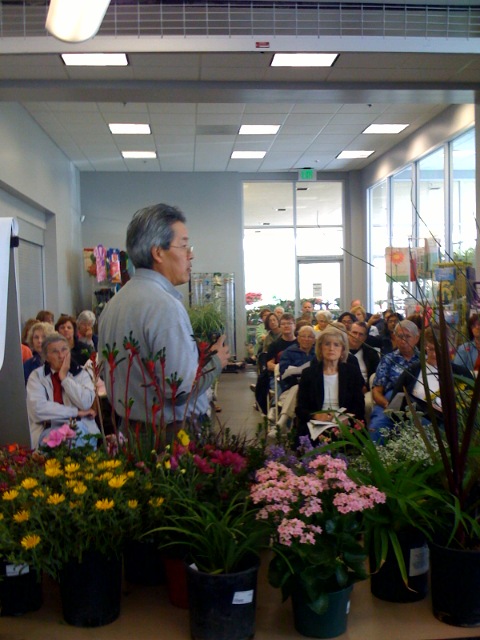|
|
|
|
Gardening Tips and Gardening Classes
|
|
|
|
Greetings!
It's been nearly 5 months since we've closed the Jeronimo store and I'm getting used to the free time. My son is on his high school freshman football team and that alone keeps both his parents quite busy.
I do miss teaching, so you can catch me at the fall series of lectures given by the GREAT PARK in Irvine. I will be presenting the FRUIT TREE lecture on Saturday, October 16 from 10am to noon.
You can also hire me for a private lesson in horticulture. This is extremely valuable if you are a new gardener or if you aren't getting the results that you expect.
I've also included a couple of valuable tips.
Enjoy!
|
|
|
 Learn Horticulture at Home
Learn Horticulture at Home
GARY'S RULES OF GARDENING
 Make this a private lesson, or a neighborhood event. Over the years Gary's Horticultural classes have been attended by thousands of novice, amateur and professional gardeners. Gary has the ability to demystify Horticulture. Gary can give you the knowledge and confidence to grow just about any plant you desire. Make this a private lesson, or a neighborhood event. Over the years Gary's Horticultural classes have been attended by thousands of novice, amateur and professional gardeners. Gary has the ability to demystify Horticulture. Gary can give you the knowledge and confidence to grow just about any plant you desire.
The Lesson Plan:
1. What do plants need?
2. Nature's Soil
3. Why is Potting Soil different?
4. Making and amending soil.
5. Installing and Establishing Plants.
6. Repairing Plants
7. Fertilization and the mineral makeup of plants
8. Irrigation
9. The differences between Annuals, Perennials, Woody Plants and the importance of Crop Rotation.
Questions are welcome throughout the presentation which lasts about 90 minutes.
The Cost
$100 for 1 or 2 students. Additional students are $20 each. The homeowner shall provide seating. Gary will bring his teaching tools as well as class notes for each student that signs up. There should be an outdoor hose available for demonstration purposes. The session can be scheduled for day or evening.
Gary Matsuoka is a California Certified Nursery Professional. He is a graduate of UC Irvine with a BS in Biology. Gary is a second generation Nurseryman. He has seen growing and installation techniques change drastically over his lifetime. Unfortunately many current practices contradict Nature and sometimes each other and result in plant failures and frustrated gardeners. By 1990 Gary was totally frustrated by the gardening and growing techniques recommended by "experts". With the help of soil researchers, knowledgeable local horticulturalists, lots of reading, and trial and error, Gary has put together his own RULES OF GARDENING. He is constantly reading, observing and refining his techniques to make certain that no contradictions exist.
|
Pots make plant roots vulnerable
 In most parts of the country, growing outdoor plants in containers is just a spring-fall fashion statement, the winters being too cold to survive in a pot. Coastal Southern California has the best growing climate for container plants, but you should be aware of the disadvantages as well as the advantages.
For this discussion I'm going to assume that you are already using my best recommendations for potting soil. This would be either our LAGUNA HILLS NURSERY TROPICAL POTTING SOIL or a mixture of sand and our LAGUNA HILLS NURSERY ACID MIX.
Plants grow best when the temperature of the soil is between 55 and 85 degrees F. Some plants like it a bit cooler, some a bit warmer. The temperature of soil in the ground is roughly the temperature of our water out of the tap. That is usually in the 50's in winter and 70 degrees in summer, pretty much ideal. Unshaded, bare soil can get warmer and this is important in a new garden when there is a lot of bare ground.
The vast majority of plant material in California is grown in black plastic containers. During cool weather (at least half the year) the black plastic keeps the soil warmer than the ground, and the plants grow faster than the climate would dictate. Unfortunately, during hot weather the black plastic can exceed 120 degrees on the sun-exposed side and literally cook the roots within.
The researchers have observed that there can be a loss of over 30% of a plant's root system when exposed to typical summer weather in a stationary (not rotated), unshaded, typical round black plastic container. This amount of loss did not lead to observable symptoms or loss of performance after installation. However, if the pot was rotated during the hot weather, exposing an additional side to the extreme heat, plant appearance and performance was significantly affected, sometimes killing the plant.
For a number of years researchers experimented with plastic containers that would turn a lighter color when exposed to heat. Currently, concerned growers merely shade the containers or whitewash the sunny side.
When you purchase a new plant you can pull it out of its container and looks at the condition of the roots on the exposed sides. You'll often notice than on one side there are a few blackened roots while the other side has many, healthy cream colored roots. Knowing the original hot (south) side will enable you to hold the plant safely until it is installed. In desert areas of California, the north side of containers (especially succulents) is often marked. Not only does this help with root health, it also prevents the more tender North side of the plant from burning in the extreme inland heat.
Hot soil in containers also makes plants more prone to suffer from root rot diseases. When soil temperatures rise, the biological activity from the roots and the multitudes of visible and microscopic soil organisms increases also. The oxygen needs of the roots, worms, bacteria, amoeba and fungi (good and bad) increase when their activity increases. Unfortunately as the temperature of water increases, its ability to hold (dissolve) oxygen decreases. Low oxygen levels allow root rot disease organisms to thrive. This is why we see less root rot during our heavy winter rains than would be expected.
When choosing pots for your garden, it is safest to select neutral or light colors for plants that will be exposed to sun. In the shade garden, color of the container doesn't matter. Unglazed clay or concrete stay cool due to evaporation of water from their external surfaces. Wood and foam pots are well insulated. Setting a container within a larger container also insulates well.
As a final note, one reason our LAGUNA HILLS NURSERY potting soils work so well, is that our main ingredient, pumice, is one of Nature's most effective insulators.
|
|
|
|
|
Late Summer/Early Fall Pruning controls height on Spring Blooming (Fruiting) Plants
This is the best time to shorten the height of the following plants, without affecting (and perhaps enhancing) their ability to bloom next spring: Almond, Apple, Apricot, Forsythia, Hydrangea, Lilac, Nectarine, Peach, Pear, Plum, and Pomegranate. Include with this group the ornamental (flowering, but fruitless) versions of the fruit trees.
Many, perhaps most, spring-blooming trees and shrubs produce their flower buds during the fall months. All summer long the energy captured by leaves is spent on growth. With the fall equinox, the growth ceases and energy is now stored and used to produce growth buds for next spring's foliage and flowers. The energy that each leaf captures is now devoted to developing the buds located at the base of that leaf. Leaves that capture more energy develop flower and foliage buds. Leaves that capture less energy develop only leaf-producing buds. Generally flower buds are produced at the top of each stem where sun is most abundant. The base of each stem produces mainly foliage buds because this area is shaded by the leaves above.
If these plants are pruned now, you will allow the lower leaves to capture more sun and develop flower buds at a lower height. Plants will still bloom if not pruned. We prune so that the fruit will develop at a height that we can reach. For most of us, this is a height of 7' or less. We prune flowering bushes so that we can see the flowers. Lilacs bloom at 10' unless pruned. Hydrangeas normally grow 5' tall, but will bloom at 3' if pruned now. Do not prune below the last few leaves on each stem.
Many fruit trees are marginally productive locally because our winters are a bit too warm to allow proper development of the flower buds. We are often just a few degrees too warm and lowering the temperature of flower buds even slightly can have a positive impact. On a still winter night the temperature at ground level can be 5 degrees colder that the air 10 feet above the ground. The shorter we can maintain the tree's height, the better chance for a good crop.
|
26285 Verona Place
Mission Viejo, California 92692
|
|
|
|
|
|
|